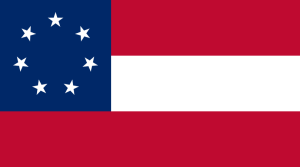A number of the stories about the removal of the so-called “Confederate flag” from above the state capitol in South Carolina have referenced that the occasion marks the first time in fifty-four years that the flag was not flown.
Fifty-four years. As in, the flag was put up in 1961. Given the defenses proffered by some of the people who wanted the flag to stay up, this 1961 raising of the flag is possibly the most interesting wrinkle of the whole sordid tale.
As you might remember from American history class, combat activities in Civil War started on April 12, 1861, when Confederate forces fired upon Fort Sumter in Charleston, South Carolina. The Confederate Army that surrounded Fort Sumter was flying this flag, known as the Bonnie Blue Flag,1 which was a short-lived symbol of the new Confederate States:
Additionally, the official flag of the Confederate States at the time of Fort Sumter was the “Stars and Bars” flag with seven stars:
Two days later, on April 14, 1861, when the Confederate Army took command of Fort Sumter, the U.S. flag was taken down and this flag, known as the “Palmetto Guard Flag” was raised over the fort:
Fast forward to 1961. South Carolina, wanting ostensibly to commemorate the 100th anniversary of the start of the Civil War, decided to fly a Confederate flag near Fort Sumter in Charleston. Yet, for whatever reason–which we will come back to–South Carolina did not choose any of the flags that would actually be relevant to South Carolina, Fort Sumter, or anything else that existed within the context that existed at the start of the Civil War. Instead, they opted for the Battle Flag of the Northern Army of Virginia.
This same Virginia flag was then moved to the South Carolina state capitol a little while later, at the request of state Rep. John A. May, who planned to introduce a resolution to fly the flag over the capitol for one year. The resolution was approved in 1962; however, it contained no date for removal of the flag. So…there it stayed.
The question, however, is why they chose the Virginia flag, rather than a flag that actually had relevance to the start of the war or the state of North Carolina. And the answer, plain and simple, is that the flag was an intentional pushback against the federal government in general and integration in particular.
You see, that’s the part that the “heritage, not hate” crowd glosses over (or, perhaps more accurately, whitewashes): the Dixiecrats specifically chose the Virginia flag as a symbol of their opposition to integration in 1948. As the Georgia State Senate Research Office reported in 2000:
From the end of the Civil War until the late 1940s, display of the battle flag was mostly limited to Confederate commemorations, Civil War re-enactments, and veterans’ parades. The flag had simply become a tribute to Confederate veterans. […]
In 1948, the battle flag began to take on a different meaning when it appeared at the Dixiecrat convention in Birmingham as a symbol of southern protest and resistance to the federal government – displaying the flag then acquired a more political significance after this convention.
As further proof of this change in the flag’s meaning, the Georgia report notes (emphases added):
Georgia of course, changed its flag [to include the Confederate battle flag] in 1956, two years after Brown v. Board of Education was decided. In 1961, George Wallace, the governor of Alabama, raised the Confederate battle flag over the capitol dome in Montgomery to commemorate the hundredth anniversary of the Civil War. The next year, South Carolina raised the battle flag over its capitol. In 1963, as part of his continued opposition to integration, Governor Wallace again raised the flag over the capitol dome.
Despite the hundredth anniversary of the Civil War, the likely meaning of the battle flag by that time was not the representation of the Confederacy, because the flag had already been used by Dixiecrats and had become recognized as a symbol of protest and resistance. Based on its association with the Dixiecrats, it was at least in part, if not entirely, a symbol of resistance to federally enforced integration. […]
Georgia’s 1956 flag and South Carolina’s and Alabama’s respective raising of the battle flag in 1962 and 1963, however, have a different meaning when placed in their historical context. Despite some nonracist uses, the Dixiecrat, segregationist, and Klan uses of the flag by that time had distorted the flag’s connection with the Confederate nation and its soldiers. The raising of the battle flag over the capitols is clear – intimidation of those who would enforce integration and a statement of firm resolve to resist integration. Likewise, when the battle flag was incorporated into the Georgia state flag, the state was in a desperate situation to preserve segregation.
It is worth remembering at this point in our story that Brown v. Board of Education was actually the consolidation of five cases from five different states. One of those cases was Briggs v. Elliott, which had been brought in — you guessed it — South Carolina. After Brown was handed down in 1954, and Brown II followed in 1955 with the instruction for states to integrate “with all deliberate speed,” South Carolina opted to continue building its “equalization schools,” rather than actually going forward with the ordered integration.
There is one issue, however, on which Charlestonians, and South Carolinians in general, are not waiting with drawn shades for a solution. That is school desegregation. Nowhere is opposition to it more adamant than this state, which is the birthplace of the state’s rights movement and has a proportion of Negroes in its population only exceeded by that in Mississippi.
Claiming in 2015 that the Virginia flag is about “heritage” is not necessarily a false statement. It only becomes false when the assertion ignores that the last sixty-seven years of that heritage is specifically, intentionally, and unambiguously about racial segregation.
While revisionist history and deluded rationalization might allow a person to convince himself that the flag isn’t racist, that doesn’t change the objective truth about the flag. And no state, county, or city in 2015 America should be in the business of flying racist symbols over public buildings, no matter the amount of revisionism and delusion involved.
Which some of you might notice was the nickname given by Rhett Butler to his daughter in Gone With The Wind↩


